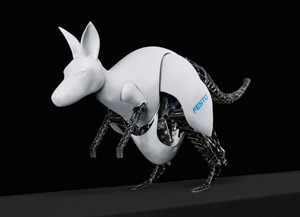Jun 4 2014
The future fields of the displayed projects from the Festo Bionic Learning Network include research activities focused on the topics of energy recovery, new drive concepts and adaptive systems, as well as functional integration and modularity. In this respect, the focus is on a holistic approach on the way to the production of the future. Fundamental technologies for networked overall systems and the interaction of man and machine are highly pertinent here.
 Like its natural role model, the BionicKangaroo can recover, store and retrieve the energy efficiently on the next jump. The BionicKangaroo is controlled using gestures. (Photo: Festo)
Like its natural role model, the BionicKangaroo can recover, store and retrieve the energy efficiently on the next jump. The BionicKangaroo is controlled using gestures. (Photo: Festo)
BionicKangaroo – Energy-efficient jump kinematics based on a natural model
A development team from Festo’s Bionic Learning Network spent two years recreating the jumping behaviour of the natural kangaroo as closely as possible and learning from it. The BionicKangaroo now demonstrates exactly what distinguishes the natural kangaroo, namely recovering and storing energy and retrieving it on the next jump. The Achilles tendon assumes an important function here, which is why it is particularly pronounced on the natural kangaroo. The function of the natural Achilles tendon is carried out with the help of an elastic band made of rubber. It is fastened at the back of the foot and parallel to a pneumatic cylinder on the knee joint. The artificial tendon cushions the jump, simultaneously absorbs the kinetic energy and releases it for the next jump.
The condition monitoring as well as the precise control technology ensure the required stability when jumping and landing. The kangaroo achieves its high jumping power with the aid of pneumatics. In the places where the highest positioning accuracy is called for, electric motors are used – for example, when it comes to controlling the tail and hip. In this way Festo uses the artificial kangaroo to show how pneumatic and electric drive technology can be combined by means of a new control generation developed by Festo to make a highly dynamic system.
Festo paid particular attention to the mobile energy supply on the artificial kangaroo. For this purpose, the team even developed two different concepts – one with an integrated compressor and one with a mobile high-pressure storage device. The movement apparatus (kinematics) is made out of laser-sintered parts reinforced with carbon. As a result, the artificial animal weighs just seven kilograms with a height of around one metre, and it can jump up to 40 centimetres high and up to a distance of 80 centimetres. The BionicKangaroo is controlled using gestures.
MultiChoiceGripper – Variable gripping based on the human hand
The MultiChoiceGripper offers a unique combination of different grip types with flexible, adaptive gripping fingers. Its fingers can therefore be switched over so that they can either grip in a parallel or centric direction, without requiring any conversion. This is enabled by two rotatable finger slots on the base body of the gripper, which are arranged either around a central point or opposite the third finger. This is inspired by the human hand with its opposable thumb, which can be rotated by 130 degrees in relation to the other fingers. Depending on requirements, between two and six finger elements can be fitted to the MultiChoiceGripper. Besides the Fin Ray® fingers, two other types of fingers can be attached.
Due to the adaptive fingers with a Fin Ray® structure, the MultiChoiceGripper is not only variable in terms of the direction of grip as the fingers themselves can adapt to a wide variety of shapes. It can therefore grip differently shaped and also very sensitive objects without additional sensor or control technology. The adaptive Fin Ray®-Fingers were designed in 2009 for the bionic FinGripper and have been continually developed ever since. For instance, since 2014 they have been made of food-compliant polyurethane, which means they can be used for the food industry.
Modular conveyor: conveying and sorting in one
With the WaveHandling pneumatic conveyor, engineers from Festo’s Bionic Learning Network have developed a modular system that can move a surface in such a way that objects are transported and sorted purposefully. Thanks to the integration of a sorting function, an additional handling unit is no longer required for this process. The conveyor consists of numerous bellows modules that deform the surface creating a wave motion that transports the objects in a targeted manner.
Inspiration for this principle was provided by waves in nature. The movement of the wind over the smooth surface of the water produces small ripples, which grow as the wind pushes against them. However, what is being moved by the waves is energy, not water. The water molecules within a wave move up and down in a circular motion, but remain in roughly the same place. Yet the energy produced causes the wave to roll over the surface of the sea. The WaveHandling system behaves in a similar way: while each individual bellows advances and retracts in the same spot, a wave moves over the surface of the conveyor.
The individual modules are self-configuring. This means that the system can be started up quickly and without programming, no matter what the layout is. A potential application of the platform is in the food industry, for automatically transporting delicate items like fruit and vegetables and sorting them for the next process step. With the WaveHandling transport system, Festo is already demonstrating how the configuration of a system will be handled by the individual modules themselves in the future.
You will find Future Concepts exhibits from Festo at A5, 111.
Further information can be found at: www.festo.com/bionics
Source: http://www.festo.com/